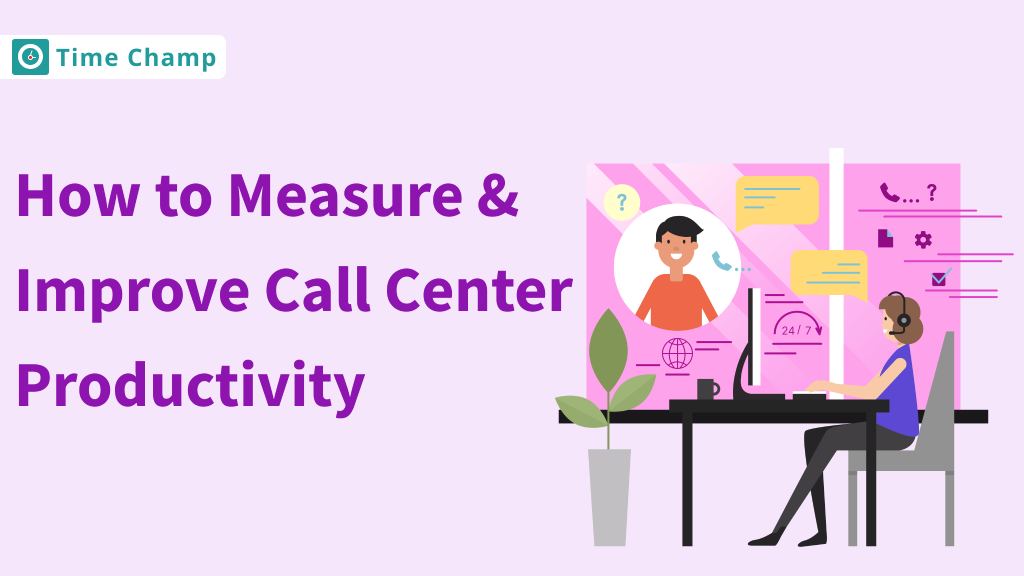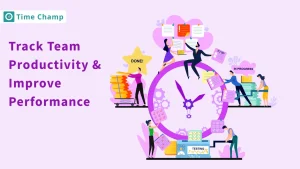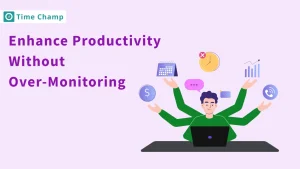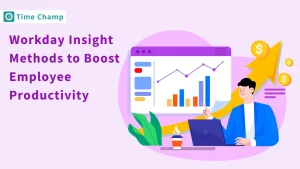As a call center manager, balancing
agent performance and well-being is
critical. You need to ensure your
team is productive and efficient
without causing burnout. But how do
you measure their productivity
effectively, and more importantly,
how can you improve it?
In this
blog, we’ll explore practical
ways to measure and improve call
center productivity, helping you
keep your team engaged, efficient,
and satisfied. By the end,
you’ll have actionable
strategies to create a more
productive and motivated call
center.
What is Call Center Productivity?
Call Center Productivity is about how well a call center achieves its goals while making the best use of its resources. It looks at things like average call handling time (AHT), how quickly agents respond, first call resolution (FCR), and how happy customers are with the service. Good productivity means the call center runs smoothly, saves time and money, and provides a great experience for customers.
In simple terms, it measures the successful customer interactions and problems solved against the time and money spent. The goal is to give great service to customers while keeping costs low.
How to Calculate Call Center Agent Productivity?
You can’t define productivity just by
looking at the total number of calls
agents make in a day. If you think
that agents who make more calls a
day are more productive and those
who make fewer are unproductive,
then you are
mistaken.
Yes!
The above
process isn’t the right way. There
are formulae to calculate call
center agent productivity.
1. Overall Call Resolution Rate
Overall call resolution rate measures the percentage of customer issues or inquiries that are successfully resolved during calls. The formula to calculate this rate is the total number of resolved calls divided by the total number of calls handled, multiplied by 100.
Call center productivity = (Total number of resolved calls / Total number of calls handled) * 100
A higher resolution rate actually
improves customer satisfaction and
loyalty, as they appreciate good and
quick service. It helps assess the
efficiency of agents and find areas
of improvement or training. It
serves as one of the productivity
metrics for agents and
teams, helping to set benchmarks and
goals.
For instance, if the
total number of calls handled by
your agents is 1000, and 850 are
resolved by them, then the formula
goes like this:
Call
center productivity = (850 /
1000)* 100 = 85%
(productivity).
2. Ratio of Output to Input
The ratio of output to input measures the time an agent spends on handling calls compared to their total work time.
Call center productivity = (Total output time / total input time)* 100
This metric measures
how productive agents are by
comparing the total time they spend
on calls including talking, being on
hold, and doing follow-up work to
the total time they are scheduled to
work. It helps managers see how well
agents are using their work hours,
to increase productive time and
reduce time spent doing
nothing.
For instance, if an
agent has a shift of 12 hours and
spends 9 hours on calls and other
tasks, then the formula
goes:
Call center
productivity = (9/12)*100 =
75%
Here, we can
see the productivity of the agent is
75%, which indicates he spent 75% of
their shift working and spent the
remaining 25% of the time on things
that weren’t work-related.
The
above two formulas help to calculate
the productivity of your agents
easily. Make sure to use them!
Metrics for Measuring Call Center Productivity
As we have seen the formulae to
calculate call center productivity,
along with that there are some
metrics that help to measure the
productivity and effectiveness of
your call center’s actions.
Let’s have a look!
1. First Call Resolution
Imagine solving a customer’s issue on
the very first call – that’s the
dream, right?
The first Call
Resolution (FCR) metric is the
percentage of issues resolved by the
customer on the first call, without
needing any follow-up. It is one of
the most critical metrics for
contact center productivity because
it directly affects both customer
satisfaction and operational
efficiency. The higher your
FCR rate, the fewer follow-up calls,
less time wasted, and happier
customers. You can calculate FCR by
dividing the number of issues
resolved on the first call by the
total number of calls.
FCR = Calls resolved in first interaction / Total number of calls
Why it matters: Customers don’t want to call back. Agents don’t want to repeat themselves. Boosting FCR not only improves productivity but also enhances the customer experience.
2. Call Abandonment Rate
The call abandonment rate metric measures the percentage of customers who hang up before speaking with an agent. A high abandonment rate means problems such as long waits or insufficient staff at peak hours. Bringing this rate down helps keep customers interested and makes sure your team answers quickly.
Call Abandonment Rate = (Total number of abandonment customer calls / total number of calls)* 100
Why it matters: Every time a call is abandoned, you might lose a customer. To keep customers happy and your call center working well, it’s important to keep this rate low.
By using this metric, you get to know about:
- Waiting time of a customer
- Ineffective call routing systems
- Understaff at peak levels
3. Customer Satisfaction Level
The customer satisfaction level metric is measured by conducting surveys, polls, or asking customers about their experience after the call. A high CS level represents productivity and meeting customer expectations.
Agents usually ask customers to give a rating on a scale of 1-5 about their experience. This metric provides direct insight into how customers feel about your service.
For instance, if an agent calls 300
customers, 250 out of 300 responded
positively (satisfied), and the
score is 75%.
This metric
focuses on customer experience,
sentiments which initially help
organizations to improve their
service levels more.
4. Net Promoter Score
Net Promoter Score (NPS) is a simple way to check how loyal your customers are. It’s based on asking one easy question: “How likely are you to recommend our company to a friend?” This score helps businesses see if customers had a good experience and if they’d suggest the company to others. A high NPS means customers are happy and willing to spread the word, which can help the business grow.
To find out the NPS, customers are asked how likely they are to recommend the company on a scale from 0 to 10. Customers are divided into three phases depending on their responses: Promoters (scoring 9-10, most likely to recommend), Passives (scribbling 7-8, okay with the company but not enthusiastic), and Detractors (scoring 0-6, not happy, possibly with negative word of mouth).
To calculate NPS, you should subtract the percentage of detractors from the percentage of promoters. The bigger this score, the happier and more loyal your customers are.
5. Average Speed of Answer
The average speed of answer is one of the call center productivity metrics which measures the average time an agent takes to answer a customer’s call. It indicates the responsiveness of a call center. Monitoring this metric helps to make sure that customer waiting time will be minimized, therefore increasing overall efficiency.
ASA = Total wait time of answered calls / total number of calls
The high ASA score percentage isn’t a good sign. According to industry standards, a good average speed for call center agents to answer is 8-9 seconds.
6. Call Transfer Rate
Call transfer rate is a call center metric where it measures the number of calls being transferred by an agent to their colleague. This can happen when an agent fails or cannot find a solution to the customer’s request, hence passing the call to a colleague where it can be the expertise the colleague has, or because the colleague deals with a different department.
It may be a symptom of several
problems that lie in the call
center. It may arise when the agents
are not trained properly, lack of
right tools, or just ineffective
call routings. It can also lead to
customer frustration, as frequent
transfers often result in longer
call times, repetition of
information, and a less satisfying
experience.
Overall, these
metrics give the areas of
improvement for better service which
leads to productivity.
7. Average Handle Time
Average Handling Time (AHT) measures the total time an agent spends on a call. It includes talk times, hold times, and after-call tasks. A shorter AHT suggests efficiency, it’s essential to balance it with quality service. Solving an issue immediately is pointless if the customer leaves dissatisfied. Monitoring this metric can help you identify areas where agents may need additional training or process improvements.
Average Handle Time = Total talk time + total hold time + total after-call work time / total number of calls handled
Why it matters: A streamlined call process that resolves issues quickly and efficiently can reduce operational costs and free up agents for more calls.
8. Service Level
Service level means the percentage of calls answered in a predefined time, usually measured in seconds. This is an important KPI to prevent longer wait times for customers. A good service level implies that your call center is capable of handling incoming traffic efficiently.
Service level = (total number of calls answered in a predefined time / total number of calls answered)* 100
Why it is important: Customers don’t appreciate it when they are made to wait for too long. Monitoring this metric helps to identify bottlenecks before they become major issues and ensures smooth operations.
9. Occupancy Rate
Occupancy rate is a simple way to
measure how much time call center
agents spend working on calls or
doing tasks like writing notes after
the call. It shows how busy they are
compared to how much time they are
waiting for the next call.
If
the occupancy rate is too high,
agents might be working too much,
which can make them tired and cause
mistakes. If it’s too low,
agents are waiting around too much,
meaning there might be too many
agents on duty.
A good
occupancy rate is usually between
70% and 85%. This means agents are
busy enough to stay productive but
not working too much that they get
tired. Keeping an eye on this rate
helps managers make sure they have
the right number of agents working,
so everything runs smoothly and
agents stay happy.
10. Missed Calls
Missed calls are a key way to see how
well a call center is working. This
number shows how many customer calls
were not answered. When many calls
are missed, it usually means the
agents are too busy or not handling
calls well. Missed calls can
frustrate customers because they
can’t get help when they need it.
This might lead to more calls later
when customers try to reach out
again.
A high number of missed
calls is a bad sign. This might mean
there aren’t enough staff available
when it gets busy, or it could mean
that agents are taking too long to
finish calls. To solve this and make
things better, call centers should
have the right number of agents
ready to help customers. It is
better to train agents to answer
calls more quickly.
The
above-mentioned are some of the best
metrics which are used widely across
the countries.
Start Tracking Productivity Metrics with time champ and transform the way you work
Gain insights, optimize workflows, and achieve your goals faster than ever.
Sign Up for FreeBook DemoWhat are the Causes of Low Productivity in Call Center Agents?
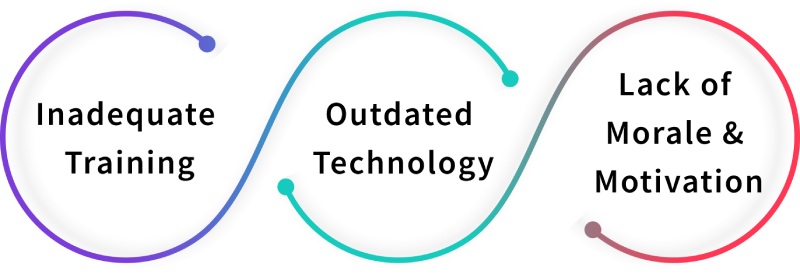
Before improving productivity, it’s important to understand what’s slowing your team down. Low productivity in call center agents can happen for many reasons, both inside the team and due to outside factors. Let’s look at the common reasons!
1. Inadequate Training
Poor training is the major reason why
contact center agents are not
productive. Without adequate
training, agents usually find it
difficult to understand company
rules and procedures and the
technology they are expected to use.
If a customer asks any
question that the agent isn’t well
trained on, it may lead to an
unsatisfactory customer which will
decrease the overall efficiency
and productivity of the
agent. This would make them handle
calls less efficiently. When agents
do not have all the information they
need, it leads to longer call
durations because they need to look
things up or find the right answers.
This can be frustrating to both
customers and agents as well.
Additionally, if agents aren’t
trained well, this can lead to more
follow-up calls and put more stress
on resources.
2. Outdated Technology
Old technology can slow down work in contact centers. Outdated tools can create problems that make it hard for agents to do their jobs. Slow systems can cause delays in answering calls, frustrating both agents and customers. Also, old software might not have important features like automatic call routing or customer management, making it harder for agents to help people. Technical issues happen more often with old technology, leading to downtime that stops work and reduces the number of calls agents can take.
3. Lack of Morale and Motivation
When call center agents are not happy
or motivated, it can really hurt how
much work gets done. If agents don’t
feel appreciated, they might not do
their jobs well. This can make more
agents leave their jobs, which means
constant training for new workers.
This slows down work because new
agents need time to learn what to
do.
Also, unmotivated
agents often don’t provide
good customer service, which makes
customers unhappy. A stressful work
environment can also lead to
burnout, causing agents to miss work
and making productivity drop even
more.
Effective Tips to Improve Call Center Productivity

1. Provide a Pleasant Work Environment
A happy workplace is a productive
workplace! Usually, call
centers have a busy work environment
where agents are always busy in
talking on calls, frustrating,
annoying, etc. Unlike this, provide
a pleasant environment to agents
where they can work peacefully. Make
sure your contact center is
comfortable for everyone. Using
comfy chairs, good lighting, and
keeping things tidy. When employees
feel good about where they work,
they’re more likely to do their
best. It’s really important to
teach employees using examples from
their daily work. This helps them
learn how to handle different
customers and keep them happy.
Creating a pleasant
environment doesn’t only mean
providing the best resources but
also the work culture that impacts
an agent’s productivity. Fostering a
culture of respect and collaboration
encourages open communication and a
sense of belonging among team
members.
2. Create a Training Program
Not everyone understands in the first attempt. Conduct training programs for agents to train them better. From handling the phone system to answering customer questions easily, train them for the best. Regular training helps everyone stay confident, making their jobs easier and customers happier. Make them keep updated about new technologies and processes which helps them to be efficient. This program should cover not only technical skills and product knowledge but also customer service best practices.
3. Use the Right Software
Some contact centers are not updating themselves with the best software. It is important to opt for the right software which is essential for better performance. Choose software that allows them to manage calls easily, track customer information, get quick answers, help them to work better, and provide the best service, which makes customers happier.
Upgrading to modern contact center technology makes work easier and more efficient for both agents and managers. The right tools help agents serve customers on the platforms they use the most.
Some common tools like Automatic Call
Distributors (ACDs) send calls to
the right person, Interactive Voice
Response (IVR) helps customers
handle things on their own, and CRM software for
call center to keep track of
customer info. Other useful tools
connect phones to computers (CTI),
make outgoing calls, schedule shifts
(WFM), check call quality (QMS), and
cloud systems, speech tools, and
chatbots.
“Some teams also explore how AI call assistants can quietly support routine inquiries or simple call-handling tasks, helping agents stay focused on more complex customer issues."
Choose the right
software based on your business
size, customer interactions, budget,
and needs.
4. Plan Gamification and Rewards Systems
Who doesn’t love to have fun at work?
Introduce gamifications
and reward systems to boost
employee engagement. This
motivates them to perform their
best. You can use leaderboards,
badges, contests, and rewards to
recognize top performers.
They
have been working since morning, and
when they eventually make better
progress than their colleagues, they
deserve some rewards. These rewards
can take any form. Adding a bit of
fun to their workday helps them stay
productive and perform even
better than usual.
Flexible Scheduling
Life can be busy, and sometimes
employees need flexibility.
Agents often have to put in long
hours or handle a lot of calls. Life
outside of work can also be
stressful, so it’s important to give
employees some flexibility. Letting
workers choose their hours or work
from home helps them balance their
job and life. This is important in a
call center because workers handle
many calls and deal with stress.
When call center agents can
change their schedules, they feel
more in charge. This helps them feel
less stressed and focus better on
their work. Happy and rested workers
usually do a better job, help
customers more, and keep the call
center running well.
Regularly Update Processes
Keep things up-to-date by regularly
checking how your contact center
operates. Ask employees what is
working well and what isn’t. Making
small changes can help everyone work
better and improve the customer
experience.
Old ways of doing
things might not work well with
today’s technology, products, and
customer needs. If you don’t update
these methods, it can cause slower
responses and frustration for both
workers and customers. It’s
important to improve
how you communicate, connect
different software, and manage
incoming calls to meet what
customers want.
Monitor Performance Frequently
Keep track of how everyone is doing!
It’s important to check performance
often to find ways to improve. Use
simple measures like how long it
takes to handle calls and customer
satisfaction scores. You can also
use tools like Time
Champ, which
helps by showing you detailed
information about how productive
each employee is.
Time Champ is
an employee monitoring software
where it monitors the performance of
your employees and gives detailed
reports on it. You can customize
websites, and apps into productive,
non-productive, neutral categories,
where you will get a better idea
about their activities. With Time
Champ, you can easily see how each
employee is doing. Giving regular
feedback based on this information
helps workers get better at their
jobs. When employees know how they
are doing and get help, they feel
more motivated and can give better
service to customers.
Boost your call center productivity with Time Champ
Try out and see the difference today!
Sign Up for FreeBook DemoFinal Thoughts
In conclusion, it’s important to check and improve how a call center works so that customers get great service and costs are kept low. By using simple ways to measure how well things are going, giving good training, creating a friendly workplace, and letting employees choose their schedules, call centers can have a happy and hardworking team. Regularly looking at how things are done helps agents better meet what customers need. All of these steps make customers and employees happier, which helps the call center do well.
Frequently Asked Question
Improving contact center productivity has several key benefits. It helps make customers happier, lowers costs, and boosts employee morale. When calls are handled efficiently, customers get the help they need quickly, which builds their loyalty to the company. Plus, productive agents can take more calls, which means the company uses its resources better and has the chance to earn more money.
Technology helps call centers work better. It can do simple tasks on its own, make it easy for agents to find customer info, and help them talk to each other. Tools like AI chatbots, call-tracking software, and cloud systems can make calls quicker and send them to the right person. This lets agents spend more time helping customers with harder questions.
Employee engagement is very important for how well call centers work. When workers feel happy and involved, they do a better job, help customers more, and stay with the company longer. Things like saying thank you, fun team activities and open chats can make the workplace nicer. This helps agents do their best and keeps customers happy.
To handle busy times better, call centers can do a few things. They can hire extra workers when there are lots of calls, use data to guess how many calls to expect, and create flexible schedules. Also, letting customers help themselves by finding answers to common questions can take some work off the agents.
To do good agent performance reviews, it’s best to set clear goals that are easy to understand. Use both numbers and simple feedback to see how they are doing. Giving helpful advice can improve their work. Having regular one-on-one meetings, reviews from coworkers, and self-checks can make the process better. It’s also important to celebrate what agents do well and kindly show them how they can improve.
